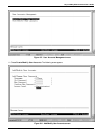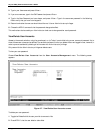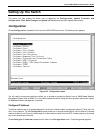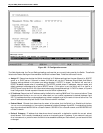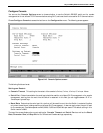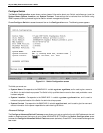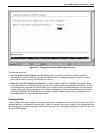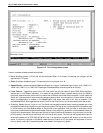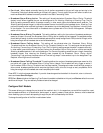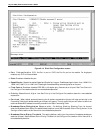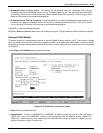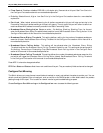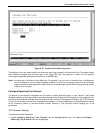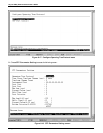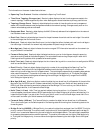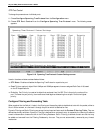
24-port NWay Ethernet Switch User’s Guide
40 Using the Console Interface
♦ Port Lock When locked, automatic learning for all stations connected to this port will stop and entries in the
Forwarding Table for all devices residing on this port will age out. The only traffic this port will allow is traffic from
machines whose MAC address is manually entered in the Static Forwarding Table.
♦ Broadcast Storm Rising Action This setting will be activated when Broadcast Storm Rising Threshold
(below) is met. When triggered, the port can be configured to Do Nothing, Blocking or Blocking-Trap. The Do
Nothing setting causes the switch to operate normally, in other words, ignore the broadcast storm condition. The
Blocking setting causes the port to drop all broadcast frames, thus isolating the broadcast storm. Blocking-Trap
performs the same action as Blocking, except it also sends a trap to the designated Trap Recipient informing them
of the situation. For more information on broadcast storms, please refer to the Switch Management Concepts
section of this manual.
♦ Broadcast Storm Rising Threshold This setting defines a ceiling for the number of broadcast packets per
second on this port. Once met, the Broadcast Storm Rising Action (above) will be triggered. The assigned number
should be high enough to allow normal broadcast packets (which comprise significant traffic) to be let through, while
being low enough so that broadcast storms can be detected early.
♦ Broadcast Storm Falling Action This setting will be activated when the Broadcast Storm Rising
Threshold and then the Broadcast Storm Falling Threshold (below) is met. This setting can be configured to
Do Nothing, Forwarding or Forwarding-Trap. The Do Nothing setting causes the switch to operate normally,
in other words, ignore the situation. If the port had met the Broadcast Storm Rising Action criteria and started
Blocking broadcast packets, it will continue doing so. The Forwarding setting causes the port to begin forwarding
broadcast frames, thus removing the Blocking state imposed by the Broadcast Storm Rising Action.
Forwarding-Trap performs the same action as Forwarding, except it also sends a trap to the designated Trap
Recipient informing them of the situation.
♦ Broadcast Storm Falling Threshold This setting defines the number of broadcast packets per second on this
port which will trigger the Broadcast Storm Falling Action (above). This threshold will only trigger an action if
the Broadcast Storm Rising Threshold has first been reached. The assigned number should be high enough to
allow normal broadcast packets (which comprise significant traffic) to be let through as early as possible, while
being low enough so that broadcast storms are completely eliminated.
Press APPLY to let the changes take effect. If you wish these changes to be the default for the switch, return to the main
menu and choose Save Changes.
STP Port State (whether the Spanning Tree Protocol is enabled or disabled on this port) and Status reflect the current
conditions of the port. They are read-only fields and cannot be changed.
Configure Slot1 Module
This screen allows you to change the port state of the module in slot 1 in the case when you would like to partition a port
due to excessive collision, or for observation, device repair, or security reasons. Great caution, however, must be observed
when disabling a port, since all data passing through the port will be discarded by the Switch.
To change the configuration of the Slot1 module shown below:



